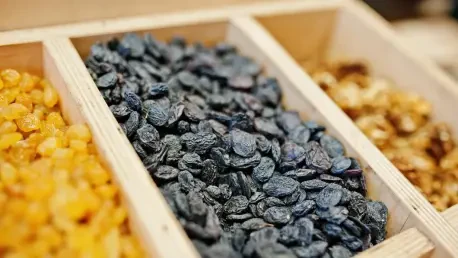Overview of the California Raisin Industry
In the heart of California’s agricultural landscape, the raisin industry, once a towering symbol of the state’s global dominance in dried fruit, is grappling with a stark reality of decline, having seen its output dwindle dramatically over recent decades. This sector, historically celebrated for its vast production and cultural significance, has prompted concern among stakeholders as it struggles to maintain its foothold in the state’s economy. With iconic names like Sun-Maid and National Raisins still leading the charge, the industry remains a vital, though shrinking, part of California’s agricultural framework, focusing on production, processing, and export markets.
The scope of this industry encompasses a network of growers, processors, and cooperatives such as the Raisin Bargaining Association (RBA), which play pivotal roles in negotiating prices and advocating for farmers. However, economic pressures have driven a noticeable shift in land use, with many growers converting vineyards to more lucrative crops like almonds and pistachios, lured by higher returns and rising land values. This transition reflects a broader challenge to maintaining raisins as a cornerstone of California agriculture.
Technology has begun to reshape farming practices, introducing efficiencies through mechanization and new drying methods, while associations like the RBA work to stabilize the market for growers. Despite these advancements, the industry faces an uphill battle to retain its historical prominence. The economic importance of raisins, once a key driver of rural livelihoods, is now overshadowed by competing agricultural priorities, setting the stage for a critical examination of its future.
Current Trends and Market Dynamics
Key Trends Shaping the Industry
A significant trend impacting the California raisin sector is the steep drop in production, with output halving from its peak over the past few decades to under 200,000 tons annually. This decline is largely attributed to growers prioritizing alternative crops that promise better financial outcomes. Such a shift underscores a fundamental change in agricultural strategy, where profitability often trumps tradition.
Emerging opportunities, however, are visible in the adoption of new grape varieties designed for on-vine drying, which reduce labor costs, alongside a growing interest in organic and regenerative agriculture. Consumer preferences are also evolving, with increasing demand for sustainable and high-quality dried fruit, though this comes with the challenge of competing against lower-cost producers like Turkey. These dynamics highlight a market increasingly focused on value over volume.
Rising production costs and retailer resistance to price increases amid food inflation further complicate the landscape. Growers face squeezed margins as input expenses climb, while market drivers push for competitive pricing that often fails to reflect true costs. This tension between sustainability for farmers and affordability for consumers remains a defining issue for the sector.
Market Performance and Future Projections
Current production levels paint a grim picture, with yields at risk of falling below 150,000 tons in the near term due to adverse weather conditions like heavy rains. Pricing struggles persist, as the RBA holds steady at $2,020 per ton despite a 10-15% increase in costs for growers, creating an unsustainable financial burden for many. These figures reveal a sector under significant strain, grappling with immediate economic realities.
Looking ahead, the industry appears poised for further contraction, shifting away from a volume-driven model toward one focused on quality and specialization. California’s global ranking has slipped to fourth, trailing behind dominant players like Turkey, yet there is potential for growth in niche export markets that value premium, sustainably produced raisins. This pivot could redefine the sector’s role on the world stage.
Projections suggest that while regaining past dominance is unlikely, a strategic focus on high-value segments and innovative practices may offer a lifeline. Market performance will depend on balancing cost challenges with consumer willingness to pay for differentiated products. The coming years, from 2025 to 2027, could see incremental progress if these targeted efforts gain traction internationally.
Challenges Facing the Raisin Sector
Economic pressures stand as a primary obstacle, with stagnant prices failing to cover escalating costs, often resulting in negative returns for growers. Many small family farms, typically operating on modest acreage, find themselves unable to sustain operations under such financial strain. This persistent imbalance threatens the very foundation of the industry, pushing some out of business altogether.
Environmental hurdles compound these woes, as water scarcity, exacerbated by California’s drought-prone climate, limits irrigation capabilities critical for grape cultivation. Additionally, weather-related damage from heavy rains and soaring energy costs for processing further erode profitability. These natural and operational challenges create a precarious environment for consistent production.
Global competition, particularly from Turkey, presents another formidable barrier, with lower production costs, government subsidies, and minimal regulatory oversight allowing foreign producers to undercut California raisins in key markets. Addressing this disparity requires innovative solutions like supply chain collaboration, cost-reducing technologies, and advocacy for fair trade policies to level the playing field and protect domestic growers.
Regulatory and Policy Landscape
California’s stringent labor and food safety standards impose significant compliance costs on growers and processors, often outpacing those faced by international competitors. These regulations, while aimed at ensuring quality and worker welfare, place an additional burden on an already struggling sector. Navigating this complex regulatory framework demands substantial resources, diverting focus from growth initiatives.
Government support yields mixed outcomes, with criticism directed at limited state-level assistance that fails to address immediate grower needs. In contrast, federal USDA programs, such as the Market Access Program (MAP) and school lunch initiatives, receive commendation for providing consistent aid and market opportunities. This dichotomy reflects a broader tension between local and national policy priorities.
Trade policy challenges persist, with historical barriers like high duties in markets such as South Korea partially resolved, but ongoing inequities with subsidized competitors remain unresolved. The RBA plays a crucial role in advocating for reforms on tariffs, immigration policies affecting labor, and expanded market access. Such efforts are vital to countering structural disadvantages and fostering a more equitable global trade environment.
Future Prospects and Innovation Pathways
Innovation stands at the forefront of the industry’s potential revival, with new grape varieties offering reduced labor costs and enhanced efficiency, though modernization expenses can reach up to $20,000 per acre. This high barrier to entry limits adoption among smaller growers, yet remains essential for long-term competitiveness. Advances in vineyard systems signal a transformative approach to traditional farming challenges.
Market disruptors, notably Turkey’s dominance, underscore the need for differentiation through quality and sustainability to maintain relevance. Niche markets for organic and regenerative products, especially in export regions, present promising avenues for growth. Capitalizing on these specialized segments could position California as a leader in premium dried fruit categories.
Sustainability initiatives, including investments in solar energy and improved water management, align with broader environmental trends shaping agriculture. These efforts not only address resource constraints but also appeal to eco-conscious consumers, enhancing market appeal. As economic and ecological pressures mount, such strategies will likely define the industry’s trajectory in the years ahead.
Conclusion and Strategic Outlook
Reflecting on the journey of the California raisin industry, it is evident that a storied legacy has collided with the harsh modern realities of decline and competitive strain. The sector has witnessed a profound transformation, marked by halved production and a diminished global standing, yet it also reveals pockets of resilience through innovative practices and a focus on quality.
Moving forward, stakeholders are encouraged to prioritize sustained investment in modern farming systems to curb costs and boost efficiency. Forging stronger partnerships with retailers to align pricing with true production expenses emerges as a critical step, alongside relentless policy advocacy to address trade inequities. These actions promise to fortify the industry’s foundation.
Additionally, exploring untapped potential in niche markets and deepening commitment to sustainability practices offer actionable pathways to relevance. By embracing specialization and fostering collaboration across the supply chain, the California raisin sector can chart a course toward enduring viability, ensuring its historical significance evolves into a renewed, impactful presence.









